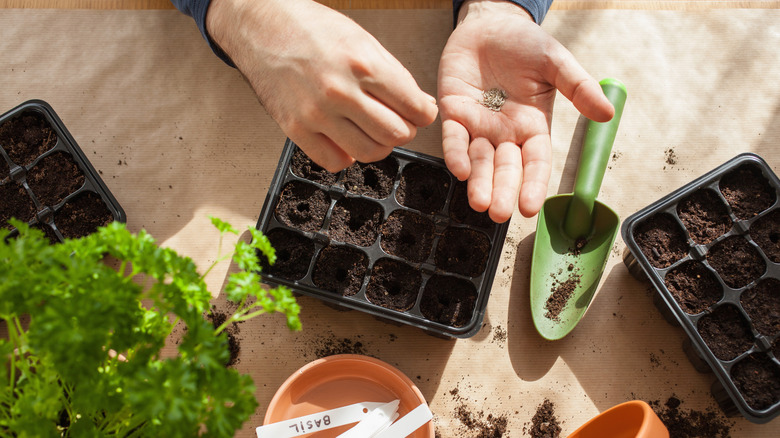One Of The Easiest Vegetables To Grow Indoors Is A Common, Delicious Green
Who among us isn't on a mission to eat more leafy greens? These nutritious vegetables are packed full of essential vitamins, fiber, and antioxidants that contribute to a healthy, balanced diet. That said, leafy greens can be expensive, and with the average cost of groceries increasing, you might be wondering if it's possible to grow them yourself. In short, yes, and there's one common type that's particularly easy to grow indoors: arugula (Eruca sativa).
A peppery green from the mustard family that's a staple in Italian and other Mediterranean cuisines, arugula springs to life quickly (and with minimal fuss) when planted from seed. Growing it in your home in fall or winter is totally possible — in fact, this annual herb prefers cooler temps, though it can be grown indoors year-round. Plant it correctly, and you'll yield bunches of delicious greens in just a few weeks. You can even grow arugula side by side with spinach (Spinacia oleracea), another edible leafy green. Here's everything you need to know to grow arugula indoors successfully.
Tips & tricks for growing arugula indoors
When growing arugula, buying seedlings or starter plants is a big mistake. Growing it from seeds is more affordable and less likely to stress out your plant. Also worth noting: It's best to purchase seeds for a fast-growing variety of cultivated arugula, not wild arugula (Diplotaxis tenuifolia). The former germinates faster and has a milder, more palatable flavor.
As far as growing arugula goes, it's pretty straightforward — this leafy green is famously unfussy. Sprinkle some seeds in a container filled with light, well-draining potting soil, and moisten it to encourage germination. Cover the container, and check on your seeds three to five days later. At this point, they should have sprouted, and you can relocate your plant to a sunny tabletop, countertop, or windowsill in your home. The ideal temperature for arugula is between 60 to 70 degrees Fahrenheit. Water your plant two to three times per week, but make sure it doesn't get too soggy. If it's super dry in your home over the winter, you can mist your plant or set up a humidifier. Just be sure to keep it away from any radiators or vents. Heat stress can be detrimental to arugula.
Wondering when is the best time to harvest arugula? You're good to go once your plant's leaves are a couple of inches long, which is generally four to six weeks after planting. Something to bear in mind is that younger arugula leaves taste tangy and peppery, almost mustard-like, while older ones are spicier and more bitter. It's a good idea to harvest leaves often. This will support the growth of new leaves on a mature arugula plant and keep it from bolting. With proper care, you can expect to get several weeks' worth of leaves out of your arugula plant.

